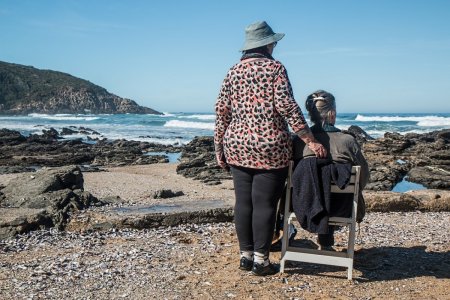This new report reveals a shocking truth about rate peg changes affecting pensioners: ‘It’s hurting big time’
Australians, especially struggling pensioners, are facing the escalating cost of living, causing significant financial strain for those relying solely on fixed incomes to support themselves and their families.
One pensioner greatly affected by these rising prices has revealed the grim cost of these rate peg changes should they come to pass.
The Independent Pricing and Regulatory Tribunal (IPART) in New South Wales (NSW) recently released a report detailing changes to the rate pegging system.
The tribunal defines the rate peg as ‘the maximum percentage amount by which a council may increase its general income for the year’.
Jim Howard, a Narrandera, New South Wales resident, estimated that he would soon have just $9 left per day for food after he pays his annual rates, bills and insurance if a peg rate change comes to pass.
According to Mr Howard, his rates would increase to $2,100 annually from $1,800 if his local council moves to apply for a Special Rate Variation (SRV) with IPART.
‘As soon as that $300 extra comes in, it's coming down to about $9 [a day]—you've got to feed yourself with that,’ shared Mr Howard.
‘There's no leeway for a pensioner, he's stuck there whether he likes it or not.’
Mr Howard is one of the many pensioners nationwide who are struggling with the rising cost of living, affecting every aspect of his life.
‘It's hurting big time,’ pointed out by Mr Howard.
‘I've got my wife in care and that costs me extra money, I've got no money left as far as extras.’
‘You don't go out, you don't socialise.’
IPART said it would be changing the way it sets the rate peg to streamline more with how council spending is done.
‘The new methodology will better reflect costs and be more timely and tailored to each council,’ explained an IPART spokesperson.
Among the changes mentioned in the tribunal’s final report is the division of the 128 NSW councils into metropolitan, regional, and rural groups to account for widely different base costs.
A new Base Cost Change (BCC) model will also be adopted to more accurately factor in councils' employee, asset, and operating costs.
IPART recognised that NSW councils would continue to face financial difficulties even with changes to the rate-pegging system.
Consequently, it proposed a review of the state government's financial model.
Local Government Minister Ron Hoenig confirmed his request for IPART to conduct this review during budget estimates.
‘Financially, the industry generally is in a fair bit of crisis in terms of their financial sustainability, I want to get to the bottom of why that is,’ noted Mr Hoenig.
‘The solution isn't always throwing them money, the solution is, I think, to give councillors greater oversight and control of their expenditure.’
Meanwhile, councillors can request a Special Rate Variation (SRV) if they deem it necessary to exceed the rate peg for total rates revenue.
This year, 17 councils applied for SRVs, with 14 receiving approval and three partial approval.
Narrandera Shire Council is also considering applying for an SRV, slated to commence next year.
George Cowan, who heads the town’s council, cited the necessity for this variation due to the prolonged impact of the rate pegging system and the need for funding for projects such as stormwater upgrades.
Despite challenges, he sees the recent rate peg changes as a positive step.
‘Most importantly, what the previous system had done was to restrict councils' income to a level below what was needed over a long period of time,’ explained Mr Cowan.
‘The evidence of that failure is the fact that three-quarters of the councils in NSW have had to go through this SRV process [since 2016].’
‘It's simply not good enough.’
IPART avoided addressing inquiries regarding the potential decrease in Special Rate Variation (SRV) applications with the implementation of the new rate peg methodology.

Members, what do you think of this story? Share your thoughts in the comments below!
One pensioner greatly affected by these rising prices has revealed the grim cost of these rate peg changes should they come to pass.
The Independent Pricing and Regulatory Tribunal (IPART) in New South Wales (NSW) recently released a report detailing changes to the rate pegging system.
The tribunal defines the rate peg as ‘the maximum percentage amount by which a council may increase its general income for the year’.
Jim Howard, a Narrandera, New South Wales resident, estimated that he would soon have just $9 left per day for food after he pays his annual rates, bills and insurance if a peg rate change comes to pass.
According to Mr Howard, his rates would increase to $2,100 annually from $1,800 if his local council moves to apply for a Special Rate Variation (SRV) with IPART.
‘As soon as that $300 extra comes in, it's coming down to about $9 [a day]—you've got to feed yourself with that,’ shared Mr Howard.
‘There's no leeway for a pensioner, he's stuck there whether he likes it or not.’
Mr Howard is one of the many pensioners nationwide who are struggling with the rising cost of living, affecting every aspect of his life.
‘It's hurting big time,’ pointed out by Mr Howard.
‘I've got my wife in care and that costs me extra money, I've got no money left as far as extras.’
‘You don't go out, you don't socialise.’
IPART said it would be changing the way it sets the rate peg to streamline more with how council spending is done.
‘The new methodology will better reflect costs and be more timely and tailored to each council,’ explained an IPART spokesperson.
Among the changes mentioned in the tribunal’s final report is the division of the 128 NSW councils into metropolitan, regional, and rural groups to account for widely different base costs.
A new Base Cost Change (BCC) model will also be adopted to more accurately factor in councils' employee, asset, and operating costs.
IPART recognised that NSW councils would continue to face financial difficulties even with changes to the rate-pegging system.
Consequently, it proposed a review of the state government's financial model.
Local Government Minister Ron Hoenig confirmed his request for IPART to conduct this review during budget estimates.
‘Financially, the industry generally is in a fair bit of crisis in terms of their financial sustainability, I want to get to the bottom of why that is,’ noted Mr Hoenig.
‘The solution isn't always throwing them money, the solution is, I think, to give councillors greater oversight and control of their expenditure.’
Meanwhile, councillors can request a Special Rate Variation (SRV) if they deem it necessary to exceed the rate peg for total rates revenue.
This year, 17 councils applied for SRVs, with 14 receiving approval and three partial approval.
Narrandera Shire Council is also considering applying for an SRV, slated to commence next year.
George Cowan, who heads the town’s council, cited the necessity for this variation due to the prolonged impact of the rate pegging system and the need for funding for projects such as stormwater upgrades.
Despite challenges, he sees the recent rate peg changes as a positive step.
‘Most importantly, what the previous system had done was to restrict councils' income to a level below what was needed over a long period of time,’ explained Mr Cowan.
‘The evidence of that failure is the fact that three-quarters of the councils in NSW have had to go through this SRV process [since 2016].’
‘It's simply not good enough.’
IPART avoided addressing inquiries regarding the potential decrease in Special Rate Variation (SRV) applications with the implementation of the new rate peg methodology.
Key Takeaways
- Pensioners across Australia are struggling financially due to increasing rates, forcing some to spend as low as $9 a day on food.
- The Independent Pricing and Regulatory Tribunal (IPART) is set to change the methodology of setting the rate peg, the maximum amount a council can raise its income from ratepayers in a year.
- The new process aims to reflect changing council costs more accurately.
- Despite these modifications to the rate pegging system, NSW councils are still predicted to face financial hardship, and it has been suggested the state government should review its financial model.
- Councils can request a Special Rate Variation (SRV) if they need total revenue to exceed the rate peg.
- In 2021, 17 councils applied for SRVs, with 14 approved and three partially approved.









